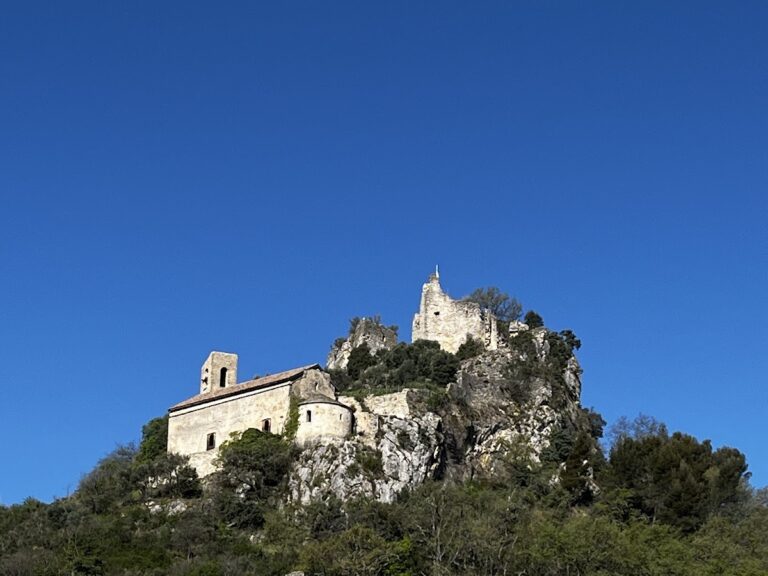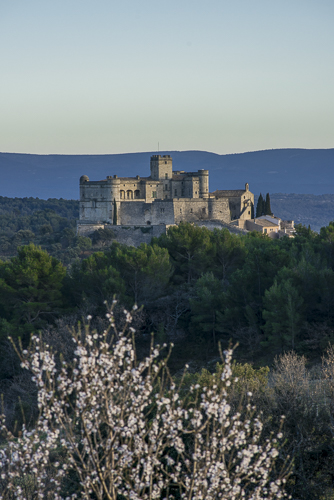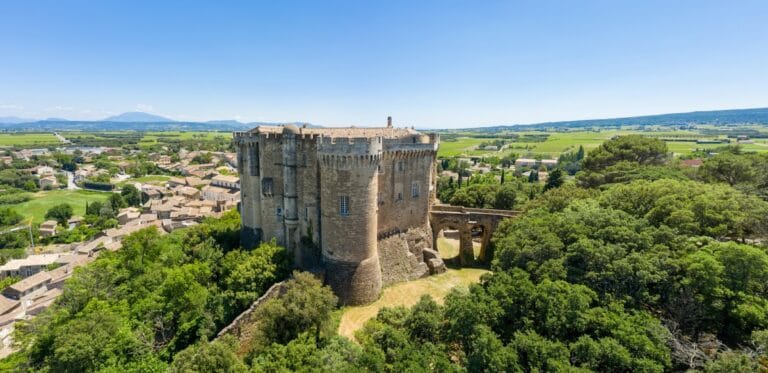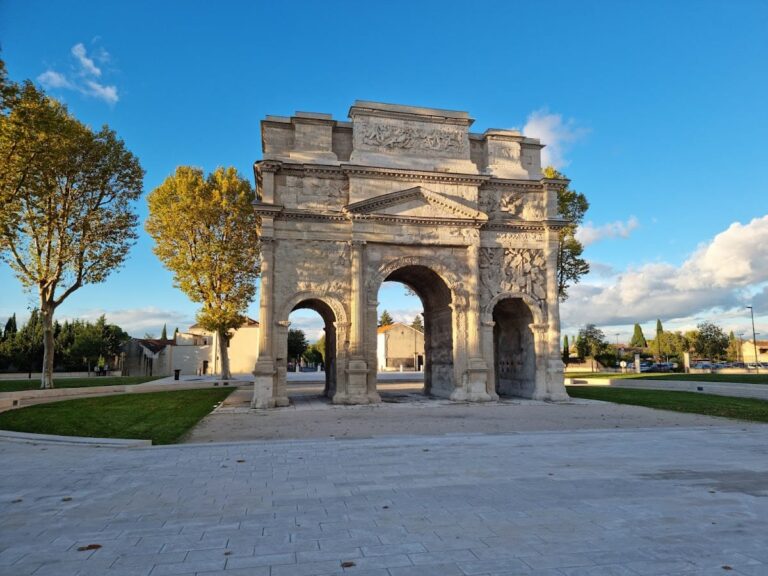Vaison-la-Romaine: A Roman Municipium and Historical Site in Southeastern France
Table of Contents
Visitor Information
Google Rating: 4.5
Popularity: Medium
Google Maps: View on Google Maps
Official Website: www.provenceromaine.com
Country: France
Civilization: Roman
Remains: Burial, City, Civic, Domestic, Economic, Entertainment, Infrastructure, Military, Religious, Sanitation
Context
Vaison-la-Romaine is situated in southeastern France within the Provence-Alpes-Côte d’Azur region, occupying a strategic position along the Ouvèze River valley near the foothills of the Vaucluse Mountains. This location provided access to fertile alluvial plains and reliable water sources, which supported continuous human habitation from the Iron Age onward. The site’s topography includes both riverbanks and an elevated plateau known as Puymin, which influenced the spatial organization of the settlement and its defensive strategies.
The archaeological record at Vaison-la-Romaine reveals a long sequence of occupation beginning with Ligurian and Celtic groups, followed by significant Roman urban development. The site’s integration into the Roman provincial system is evidenced by extensive remains of public and private architecture. While the decline of the settlement during late antiquity is archaeologically attested, it appears to have been gradual rather than abrupt, with no clear signs of violent destruction. Excavations initiated in the 19th century have uncovered substantial Roman urban fabric, and ongoing conservation efforts aim to protect these vestiges while balancing modern urban pressures.
History
Vaison-la-Romaine’s historical trajectory exemplifies the transformation of a regional tribal center into a Roman municipium and later a medieval fortified town. Located within the Roman province of Gallia Narbonensis, the site’s development was shaped by its position at the crossroads of Celtic, Ligurian, and Roman cultural spheres. Its evolution reflects broader political and religious shifts in southern Gaul, from tribal autonomy through Roman imperial integration to Christianization and medieval reorganization.
Early Iron Age and Pre-Roman Period (8th–5th century BCE)
During the early Iron Age, the area now occupied by Vaison-la-Romaine was inhabited by Ligurian communities. Archaeological investigations have identified settlement remains and defensive walls on the left bank of the Ouvèze River, situated at the base of a rocky promontory that later became the site of the medieval upper town. These agrarian groups established their dwellings on elevated terrain, likely for defensive advantages amid the fragmented tribal landscape of southern Gaul. The material culture from this period indicates localized development without significant external influence, preceding the arrival of Celtic populations.
Celtic Vocontii Period (4th century BCE)
From the 4th century BCE, the Celtic tribe known as the Vocontii migrated into the region, merging with the indigenous Ligurian inhabitants to form a Celto-Ligurian community. Vasio Vocontiorum, corresponding to modern Vaison-la-Romaine, emerged as the political and administrative capital of the Vocontii territory. This tribal domain extended from the Durance River in the south to the Isère River in the north, bounded by the Rhône corridor and the Prealps. Archaeological and epigraphic evidence confirms Vasio’s role as a tribal center, serving as a locus for governance, assembly, and regional identity prior to Roman conquest.
Roman Conquest and Early Roman Period (125–1st century BCE)
The Roman Republic incorporated the Vocontii territory between 125 and 118 BCE, integrating it into the province of Gallia Narbonensis. Vasio was designated a civitas foederata, a federated city retaining a degree of local autonomy under Roman oversight rather than being established as a formal colony. Following the conquest, the population shifted to the right bank of the Ouvèze River, where the settlement expanded from dispersed agricultural hamlets into a more structured urban center. The latter half of the 1st century BCE witnessed accelerated urbanization, marked by the construction of monumental public works including a theatre, aqueduct, bridge, and thermal baths. These developments reflect the city’s assimilation into Roman administrative, cultural, and architectural norms.
Imperial Roman Period (1st–3rd century CE)
During the Roman Empire, Vaison-la-Romaine attained its greatest extent and prosperity, covering approximately 70 to 75 hectares in the 2nd century CE. It ranked among the wealthiest municipalities in Narbonensis, supported by a diversified economy and active civic life. The Roman theatre, likely constructed under Emperor Claudius, featured a 25-meter-high stage wall and seating for up to 7,000 spectators, hosting theatrical performances such as comedies, mimes, and pantomimes. The Puymin district contained expansive patrician residences, including the House of the Wreathed Apollo and Maison à la Tonnelle, distinguished by their size, decorative mosaics, and landscaped gardens with porticos. The La Villasse neighborhood encompassed the city’s forum, a commercial street lined with shops, public baths, fountains, and luxurious homes like the Dolphin House and the House of the Silver Bust. The Roman bridge over the Ouvèze, constructed in the 1st century CE, was a vital infrastructural link between the lower town and the elevated settlement. Archaeological evidence of workshops and riverine trade underscores the city’s economic vitality during this period.
Late Antiquity and Christianization (4th–6th century CE)
In late antiquity, Vaison-la-Romaine transitioned into an important ecclesiastical center with the establishment of a bishopric by the 4th century CE. The city hosted church councils in 442 and 529 CE, highlighting its religious prominence within the region. The decline of Roman imperial authority and the incursions of barbarian groups in the 5th century led to a reduction in urban prosperity and population. The Roman theatre’s foundations were repurposed for Christian sarcophagi, illustrating the shift from pagan to Christian funerary practices and the adaptation of existing structures for new religious functions. Despite these transformations, the city maintained a degree of continuity in occupation and ecclesiastical administration.
Medieval Period (10th–14th century)
During the medieval period, the population relocated to the defensible rocky promontory on the left bank of the Ouvèze River, constructing fortifications and a castle to address security concerns amid regional conflicts. The Abbey of Saint-Martin of Autun held significant landholdings in the area, confirmed by King Raoul of Burgundy in 924 CE. The town initially developed around the cathedral and episcopal palace in the plain but suffered repeated invasions linked to disputes between the Counts of Toulouse and the bishops. By the 13th century, inhabitants sought refuge beneath the castle, which had become papal property, fostering the growth of the medieval town that endures today. In 1361, a brief occupation by a Spanish mercenary company was repelled by local forces, reflecting ongoing instability in the region.
Early Modern Period (17th–18th century)
The 17th century witnessed the foundation of a religious confraternity dedicated to Saint Vincent within the upper town’s cathedral in 1645. This confraternity, governed by clergy and lay officials, promoted Catholic devotion and met in the Chapel of the Guardian Angel due to the absence of a dedicated chapel for its patron saint. By the 18th century, demographic shifts saw most residents resettling the plain below the upper town, indicating a gradual reoccupation of lower settlement areas and relative socio-economic stabilization.
Natural Disaster: The 1992 Ouvèze Flood
On September 22, 1992, intense autumn storms caused a catastrophic flood along the Ouvèze River, with rainfall reaching up to 300 millimeters within four hours. The flood resulted in 37 confirmed deaths and four missing persons, alongside extensive material damage estimated at over 113 million euros (2020 value). Notably, the Roman bridge survived both this flood and earlier World War II bombings, exemplifying the resilience of ancient engineering and its continued significance in the modern landscape. Recovery efforts focused on rebuilding infrastructure and reinforcing disaster preparedness in the river valley.
Daily Life and Importance by Period
Celtic Vocontii Period (4th century BCE)
During the 4th century BCE, Vasio Vocontiorum functioned as the capital of the Vocontii tribe, a Celto-Ligurian community. The social structure likely included tribal leaders and warrior elites, with daily life centered on agriculture and animal husbandry. Settlements were strategically located on elevated terrain for defense. Although direct evidence of textile or craft production is limited, local artisanal activities probably supported the community’s needs. Religious practices adhered to Celtic polytheism, though no specific sanctuaries have been identified at the site. The city’s role as a political center facilitated regional governance and tribal assemblies.
Roman Conquest and Early Roman Period (125–1st century BCE)
Following Roman annexation, Vasio evolved from a tribal capital into a civitas foederata, maintaining local governance under Roman supervision. The population relocated to the right bank of the Ouvèze River, initiating urban development characterized by planned public spaces and infrastructure. Social stratification increased, with local elites assuming Roman administrative roles such as magistrates and duumviri, as attested by inscriptions. Economic activities diversified to include agriculture—cultivating grain, olives, and vines—and artisan workshops producing ceramics and metal goods. Public amenities such as the theatre, aqueduct, and baths enhanced civic life and reflected Roman cultural integration. Domestic architecture incorporated atrium houses with mosaic decoration, indicating rising wealth. Religious life began to blend Roman deities with indigenous cults, with temples and shrines integrated into the urban fabric.
Imperial Roman Period (1st–3rd century CE)
At its height, Vaison-la-Romaine was a prosperous municipium with a diverse population including Roman citizens, local Gallic families, freedmen, and slaves. Elite households occupied large domus such as the House of the Wreathed Apollo, featuring elaborate mosaics, frescoes, and landscaped gardens with porticos used for leisure and worship. Economic life combined agriculture—producing cereals, olives, and grapes—with artisan workshops and active commerce along the Ouvèze River and road networks. The forum and commercial streets hosted markets supplying local and imported goods. Clothing ranged from woolen tunics and cloaks to dyed fabrics and jewelry among the wealthy. Public amenities like thermal baths, fountains, and the theatre served as centers for social interaction and entertainment. Religious practices encompassed Roman polytheism and local cults, with festivals punctuating the civic calendar. Civic governance operated through elected magistrates and councils, overseeing urban administration and public works.
Late Antiquity and Christianization (4th–6th century CE)
During late antiquity, demographic decline and reduced urban prosperity accompanied the waning of Roman imperial authority. Vaison-la-Romaine gained ecclesiastical prominence with the establishment of a bishopric by the 4th century CE. Bishops played central roles in civic and religious life, as evidenced by church councils held in 442 and 529 CE. Pagan practices diminished, with the Roman theatre’s foundations repurposed for Christian sarcophagi, reflecting changing funerary customs. Domestic life simplified, with reduced luxury and smaller households. Agricultural production continued at a subsistence level, and markets contracted but remained functional. Clothing styles shifted toward modest Christian attire. Religious structures expanded to include churches and cemeteries, and Christian rituals became central to daily life. The city’s governance transitioned from Roman municipal administration to episcopal authority.
Medieval Period (10th–14th century)
The medieval population concentrated on the fortified rocky promontory on the left bank of the Ouvèze River, living within walls surrounding a castle. Social hierarchy centered on feudal lords, ecclesiastical authorities, and townspeople engaged in crafts, trade, and agriculture. The Abbey of Saint-Martin of Autun influenced religious and economic life through landholdings. Subsistence relied on mixed farming, viticulture, and artisanal production. Clothing reflected regional medieval styles, with wool and linen predominating. The cathedral and episcopal palace remained focal points until the 12th century, after which the fortified upper town became dominant. Markets supplied local goods, and regional trade connected Vaison to broader Provençal networks. Religious life focused on Catholic worship, confraternities, and pilgrimage, with education primarily ecclesiastical.
Remains
Architectural Features
Vaison-la-Romaine preserves extensive architectural remains predominantly dating from the 1st to 3rd centuries CE, illustrating its development as a Roman municipium. The ancient city extended across both banks of the Ouvèze River and onto the elevated Puymin plateau. Construction techniques include ashlar masonry and Roman concrete (opus caementicium), with many buildings featuring porticos, interior courtyards, and decorative mosaics. The urban layout comprised residential, civic, and religious structures, alongside infrastructure such as bridges and baths. The city expanded notably during the 1st and 2nd centuries CE, covering approximately 70 to 75 hectares. Late antique modifications include Christian reuse of pagan structures, such as the conversion of theatre foundations into burial sites. While some remains lie beneath the modern town, others have been excavated and conserved.
Key Buildings and Structures
Roman Theatre
Constructed likely in the 1st century CE during Emperor Claudius’s reign, the Roman theatre is located on the north slope of the Puymin hill. It features a semicircular seating area arranged in 32 tiers, accommodating between 6,000 and 7,000 spectators. The stage wall originally displayed statues of imperial figures and deities, fragments of which were recovered nearby. The theatre hosted comedies, mimes, and pantomimes and underwent restoration in the 3rd century CE. Use likely ceased in the early 4th century, after which its foundations were repurposed for Christian sarcophagi and building materials in the 5th century. By the Renaissance, only two arches remained visible. Rediscovered and excavated in 1912, the theatre has been protected as a historic monument since 1862. Its structural remains include the cavea (seating area), stage wall, and orchestra space. Today, it serves as a venue for cultural events.
Roman Bridge
Dating to the 1st century CE, the Roman bridge spans the Ouvèze River at a narrow rocky section. It comprises five semicircular arches resting on rock foundations, with a total width of approximately 17 meters and a breadth of 9 meters. The bridge connected the lower town with the medieval upper city and overlooked wooden pile dike installations used in antiquity to regulate river traffic. It facilitated commercial navigation managed by guilds of navigators. Classified as a historic monument since 1840, the bridge remains structurally intact and accessible to the public. Its durable masonry and arch construction have enabled survival through floods and wartime damage.
Puymin Residential Quarter
The Puymin site on the elevated plateau contains remains of a residential district dating mainly to the 2nd century CE. It includes large patrician houses such as the House of the Wreathed Apollo, covering about 2,000 m², and the Maison à la Tonnelle, approximately 3,000 m² in area. These residences feature rich decorative elements including mosaics and sculptures. The quarter also contains a sanctuary with porticos surrounding a garden and a central building, possibly used for worship or leisure. The Roman theatre is part of this site, as are 5th-century Christian sepulchres built on the theatre’s foundations, indicating a transformation of the space in late antiquity. The Théo Desplans Archaeological Museum is centrally located here, housing artifacts from the site.
La Villasse Neighborhood
Located opposite the Puymin site, La Villasse was an affluent urban quarter with a main square serving as the city’s forum. The area includes the Street of Boutiques lined with shops, public baths, and fountains. Large houses oriented around interior courtyards are preserved, including the Maison au Dauphin (Dolphin House), originally a farm converted into a high-status residence, and the Maison au Buste d’Argent (House of the Silver Bust), named after a silver bust of a noble citizen found there. The neighborhood reflects a complex urban fabric with commercial and residential functions.
House of the Wreathed Apollo
This patrician residence at Puymin dates to the 2nd century CE and covers approximately 2,000 m². It is characterized by rich decorative mosaics and sculptural fragments. Inscriptions associate the house with a wealthy family. The layout includes multiple rooms arranged around courtyards and garden spaces, constructed with ashlar masonry and Roman concrete.
Maison à la Tonnelle
Also situated at Puymin, the Maison à la Tonnelle is a large private residence from the 2nd century CE, covering about 3,000 m². Archaeological finds include decorative mosaics and sculptural elements. The house features extensive living quarters and garden areas, indicative of affluent inhabitants.
Sanctuary with Porticos (Puymin Site)
This public religious or leisure space dates to the 2nd century CE and consists of porticos framing a garden with a central building. The structure’s function may have included worship or promenade activities. The sanctuary’s architectural remains include colonnaded walkways and garden enclosures.
Forum and Street of Boutiques (La Villasse Site)
The forum served as the main public square of the Roman city, dating to the 1st and 2nd centuries CE. Adjacent to it, the Street of Boutiques was lined with commercial shops. The area also contained public baths and fountains, contributing to urban amenities. Structural remains include paved streets, shop foundations, and bath complexes.
Maison au Dauphin (Dolphin House)
This large house in La Villasse originated as a farm and was transformed into a high-status residence during the Roman period. It is organized around interior courtyards and features masonry walls and decorative elements consistent with affluent dwellings.
Maison au Buste d’Argent (House of the Silver Bust)
Named after the discovery of a silver bust of a noble citizen, this residence in La Villasse dates to the 2nd century CE. The house’s remains include foundations and interior spaces typical of wealthy urban homes.
Sepulchres (Puymin Site)
Constructed in the 5th century CE on the foundations of the Roman theatre, these Christian burial sites reflect a reuse of pagan structures. The sepulchres are aligned along the theatre’s former cavea and include sarcophagi and funerary monuments, illustrating the Christianization of urban space in late antiquity.
Théo Desplans Archaeological Museum
Located centrally at the Puymin site, the museum houses over 2,000 artifacts spanning prehistoric to Gallo-Roman periods. The collection includes statues, mosaics, everyday objects, and the silver bust from La Villasse. The museum building is modern but situated within the archaeological zone and is accessible to visitors with reduced mobility.
Other Remains
Vestiges of Early Iron Age Ligurian and Celto-Ligurian settlements and fortifications are found on the left bank of the Ouvèze River, at the base of the rocky spur now occupied by the medieval Haute-Ville. These include defensive walls dating from the 8th to 5th centuries BCE. Remains of Roman baths (Thermes du Nord) and the villa du Paon exist but are not currently visible or accessible. Two Romanesque buildings west of La Villasse—the chapel of Saint-Quenin and the cathedral Notre-Dame de Nazareth with its cloister—are preserved. The remainder of the ancient city lies buried beneath the modern townscape.
Preservation and Current Status
The Roman theatre is among the best-preserved structures, with restored seating tiers, stage wall remains, and stabilized foundations. The Roman bridge remains structurally intact and accessible, retaining its original masonry arches. Patrician houses at Puymin and La Villasse survive as foundations and partial walls, with decorative elements conserved in situ or housed in the museum. The 5th-century sepulchres are preserved on the theatre site. Other remains, such as Early Iron Age fortifications and Roman baths, are fragmentary or buried. Restoration efforts have focused on the theatre and bridge, employing original materials where possible alongside modern reinforcements. Vegetation and erosion present ongoing challenges, and some areas are stabilized but not fully restored to preserve archaeological integrity. Local heritage authorities continue excavation and conservation work, balancing preservation with public accessibility.










